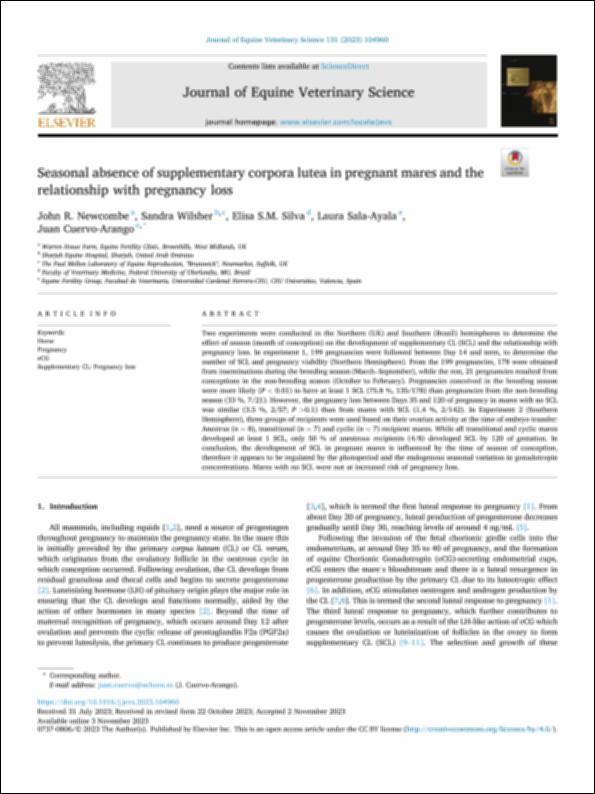Por favor, use este identificador para citar o enlazar este ítem:
http://hdl.handle.net/10637/15905Seasonal absence of supplementary corpora lutea in pregnant mares and the relationship with pregnancy loss
| Título : | Seasonal absence of supplementary corpora lutea in pregnant mares and the relationship with pregnancy loss |
| Autor : | Newcombe, John R. Wilsher, Sandra Silva, Elisa S. M. Sala Ayala, Laura Cuervo-Arango Lecina, Juan |
| Materias: | Cuerpo lúteo; Corpus luteum; Caballos; Horses; Embarazo; Pregnancy; Progesterona; Progesterone; Genética animal; Animal genetics |
| Editorial : | Elsevier |
| Citación : | Newcombe, J.R., Wilsher, S., Silva, E.S.M., Sala-Ayala, L. & Cuervo-Arango, J. (2023). Seasonal absence of supplementary corpora lutea in pregnant mares and the relationship with pregnancy loss. Journal of Equine Veterinary Science, vol. 131 (dec.), art. 104960. DOI: https://doi.org/10.1016/j.jevs.2023.104960 |
| Resumen : | Two experiments were conducted in the Northern (UK) and Southern (Brazil) hemispheres to determine the effect of season (month of conception) on the development of supplementary CL (SCL) and the relationship with pregnancy loss. In experiment 1, 199 pregnancies were followed between Day 14 and term, to determine the number of SCL and pregnancy viability (Northern Hemisphere). From the 199 pregnancies, 178 were obtained from inseminations during the breeding season (March–September), while the rest, 21 pregnancies resulted from conceptions in the non-breeding season (October to February). Pregnancies conceived in the breeding season were more likely (P < 0.01) to have at least 1 SCL (75.8 %, 135/178) than pregnancies from the non-breeding season (33 %, 7/21). However, the pregnancy loss between Days 35 and 120 of pregnancy in mares with no SCL was similar (3.5 %, 2/57; P >0.1) than from mares with SCL (1.4 %, 2/142). In Experiment 2 (Southern Hemisphere), three groups of recipients were used based on their ovarian activity at the time of embryo transfer: Anestrus (n = 8), transitional (n = 7) and cyclic (n = 7) recipient mares. While all transitional and cyclic mares developed at least 1 SCL, only 50 % of anestrous recipients (4/8) developed SCL by 120 of gestation. In conclusion, the development of SCL in pregnant mares is influenced by the time of season of conception, therefore it appears to be regulated by the photoperiod and the endogenous seasonal variation in gonadotropin concentrations. Mares with no SCL were not at increased risk of pregnancy loss. |
| URI : | http://hdl.handle.net/10637/15905 |
| Derechos: | http://creativecommons.org/licenses/by/4.0/deed.es Open Access |
| ISSN : | 0737-0806 1542-7412 (Electrónico) |
| Cubierto por: | Acuerdo Transformativo – 2023 |
| Fecha de publicación : | dic-2023 |
| Centro : | Universidad Cardenal Herrera-CEU |
| Aparece en las colecciones: | Dpto. Medicina y Cirugía Animal |
Los ítems de DSpace están protegidos por copyright, con todos los derechos reservados, a menos que se indique lo contrario.


